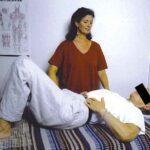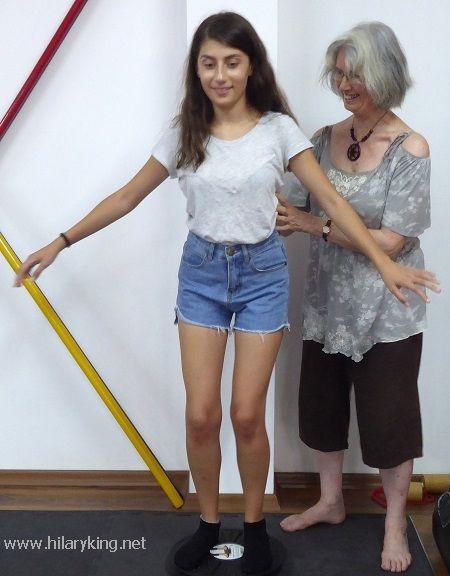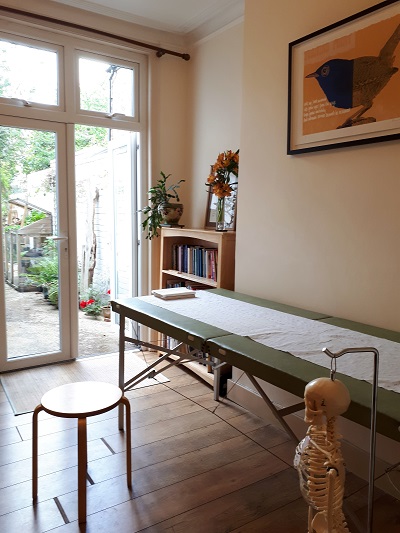
I am a qualified and experienced Alexander Technique teacher giving lessons in Harringay, London N4. I can help you learn how to be more comfortable in your body, reduce backpain strain & stress, plus gain poise and mindful movement.
Book your private lesson »
Why do people learn the Alexander Technique?
People learn the technique for a wide variety of reasons, but principally they come to learn how to move more freely and easily, whatever their lifestyle. For example:
- Many people have explored how to work at their desks in a way that reduces problems such as backpain, neck pain and RSI.
- Violinists, pianists, wind players and drummers have learned how to better look after themselves as they play their instruments.
- I spent one lesson helping a young Mum change the way she sat on the floor, so that she could more comfortably play with her toddler.
All have developed skills to help them deal with tension and life’s stresses, so they’re more able to be calmer in the face of difficulties. Pleasingly, at least seven of my pupils have gone on to train as Alexander teachers.
I have enjoyed teaching the Alexander Technique over the last 36 years and feel fortunate to have a job that I love – and one that actively looks after me as I teach. As an AT teacher, I need to be aware of my own body use whilst working and also during my everyday activities. If I didn’t, all sorts of unhelpful habits could creep in and I wouldn’t teach very well!
A quick look at my testimonials page will give you an idea of the sorts of experiences pupils have had and how lessons have helped them.
About my Alexander Technique lessons
As F M Alexander himself put it: “You are not here to do exercises or to learn to do something right’.
This is unlike many bodywork classes! Alexander lessons are rather more a process of discovery and an exploration of how our minds and bodies interact. Our thoughts and feelings get expressed in our reactions and in our bodies, and these often become habits over time. Some of these habits are unhelpful but you can learn to let go of them, once you become aware of them.
Traditional lessons use hands-on work. My hands and words will gently guide your movements as you start exploring simple activities such as sitting standing and walking, so your habits may be consciously experienced and recognised. When I teach the Alexander Technique online, my lessons predominantly use experimentation and observation as ways to develop this sort of awareness.
Then you learn to avoid automatically reacting to situations with your habits – at which point you become freed to choose new responses to situations. You will also learn to give yourself a set of instructions or ‘directions‘ so that you move with more self-awareness and poise, often reducing pain and discomfort in the process.

Applying your learning to everyday activities
Gradually you learn how to apply these changes to increasingly more complex activities. You can reduce aches and pains, gain some inner calm and develop valuable self-help skills to use throughout life. Importantly, the more you think about AT work between lessons, the quicker you will pick it up. You will also be more likely to notice changes in yourself.
As you progress in your understanding and application of the Alexander Technique, we can explore more complicated activities in our sessions. Activities such as carrying babies, using computers or playing musical instruments, gradually applying this learning to all aspects of your life – even scrubbing your teeth! Many people improve their posture, coordination and performance as a result; they tend to feel happier in their bodies and research has shown that they can also increase their sense of well being.
Frequency of lessons
Introductory lessons are 1 hour; subsequent lessons are 45 minutes long, or 30 minutes for children. It is advisable to start with one lesson a week. Later, you can drop down to fortnightly then less regular sessions as you progress. A course of about twenty lessons is recommended by STAT, so you can gain an understanding of how to use the AT in your daily life. However, research has shown that it is possible to gain something useful out of just 6 lessons. Most people enjoy their time learning the technique!
My teaching studio and what to wear
 My studio has good air circulation with French doors. Weather permitting, lessons are sometimes held outdoors in my secluded garden. Even though Covid-19 restrictions have been eased, I am still mindful of taking some precautions.
My studio has good air circulation with French doors. Weather permitting, lessons are sometimes held outdoors in my secluded garden. Even though Covid-19 restrictions have been eased, I am still mindful of taking some precautions.
You can wear ordinary comfortable clothes that allow you to move around easily and to lie down. (Please avoid hoods as these get in the way). If you are having online lessons, please wear clothes that let me see your movements clearly. You will be asked to take your shoes off.
About my fees
Please contact me to find out my full address and my current fees structure.
You may find that your insurance company will reimburse you for Alexander lessons. Also, many self-employed people in the UK can claim AT lessons as a valid expense for Tax purposes.
Alexander Technique workshops and short courses are available. However, because our patterns of ‘misuse’ are so personal to each of us, the main learning of the AT is, ideally, through individual lessons.
Reduced rate lessons for NHS staff and BAPAM referrals
I offer NHS nurses and junior level staff 10% off lesson fees. Just contact me using an NHS email address. Performers who are referred by BAPAM are also eligible for a 10% discount.
Enquire about a lesson
I am a certified member of STAT, the Society of Teachers of the Alexander Technique. This is the world’s oldest and largest professional body of Alexander Technique teachers. I’m also registered with CNHC, the Complementary and Natural Healthcare Council.
Book your private lesson »
Inclusivity Statement
I am committed to equality, diversity and inclusivity and aim to avoid bias and prejudices.
My teaching room is on the ground floor with one step into the building and a downstairs cloakroom, so it is accessible for many ambulant disabled people.